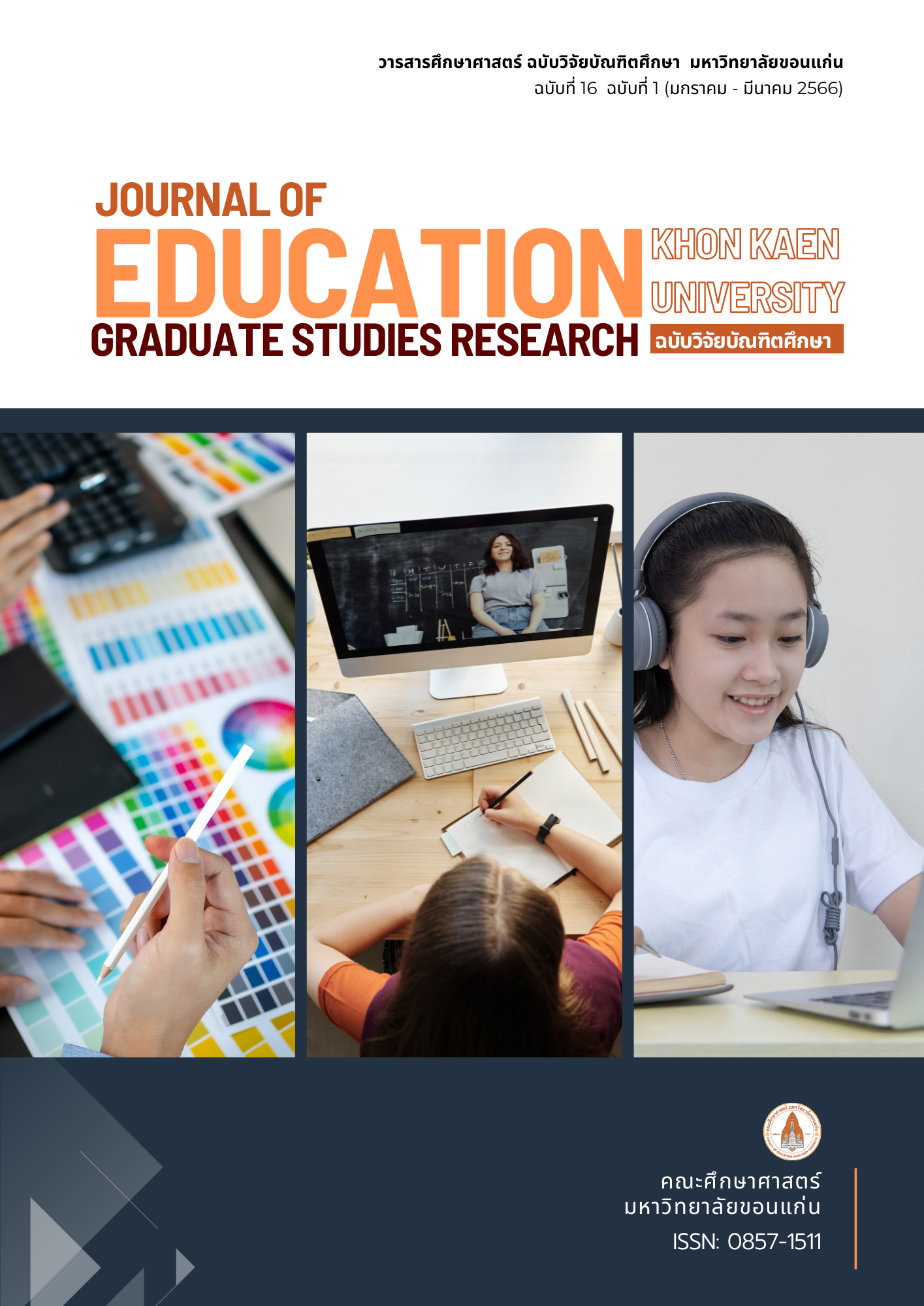Effect of Seamless STEM Learning on Newton’s Law of Motion on Scientific Explanation Competency
Main Article Content
Abstract
Currently, scientific explanation competency is considered the heart of inquiry-based learning science. In addition, digital technology has been used to enhance the competencies of learners. To meet students' learning preferences that can take place anywhere and anytime. It emphasizes linking scientific concepts to empirical evidence and providing credible reasoning for students. This study used a quasi-experimental research model with a control group and an experimental group with a pre-test and post-test to investigate the ability to explain Newton's laws of motion among 118 Grade ten students from a school in Roi-Et Province. The participants were divided into three groups: (1) A control group that learned simulation-based inquiry learning had 43 students (2) Experimental group 1 learned seamless STEM learning from formal to informal 34 students (3) Experimental group 2 learned seamless STEM learning from informal to formal 41 students. Each group received different learning interventions for the same duration of 390 minutes, and data were collected using an open-ended test of scientific explanation ability. The results of the data analysis using non-parametric inferential statistics showed that all three learning methods improved students' scientific explanation competency in every way. However, the two experimental groups that received seamless STEM learning environments showed a significantly higher improvement in their scientific explanation competency than the control group that learned through simulation-based inquiry learning. Both forms of seamless STEM learning are equally effective in enhancing students' competencies. Therefore, seamless learning is another way of learning that efficiently facilitates the development of students' scientific explanation competency.
Article Details

This work is licensed under a Creative Commons Attribution-NonCommercial-NoDerivatives 4.0 International License.
References
คมเขต เหมือนศรีชัย และนิวัฒน์ ศรีสวัสดิ์. (2558). การประยุกต์การเรียนรู้แบบไร้ขอบเขตสำหรับสาระความบันเทิงบนโทรศัพท์เคลื่อนที่. วิทยานิพนธ์ปริญญาวิศวกรรมศาสตรมหาบัณฑิต สาขาวิชาวิศวกรรมคอมพิวเตอร์ บัณฑิตวิทยาลัย มหาวิทยาลัยขอนแก่น.
นํ้าทิพย์ ศรีตะวัน และ นิวัตน์ ศรีสวัสดิ์. (2564). ผลการออกแบบการปฎิบัติการสอน เรื่อง ความสัมพันธ์ระหว่างความต่างศักย์ไฟฟ้าและกระแสไฟฟ้า ด้วยวิธีการจัดการเรียนรู้สะเต็มแบบไร้รอยต่อ. วารสารศึกษาศาสตร์ ฉบับวิจัยบัณฑิตศึกษา มหาวิทยาลัยขอนแก่น, 14(3), 1-17.
พิมพร ผาพรม และนิวัฒน์ ศรีสวัสดิ์. (2561). การส่งเสริมแนวคิดหลักและการปฏิบัติงานทางวิทยาศาสตร์และวิศวกรรมศาสตร์ของนักเรียนชั้นมัธยมศึกษาปีที่ 6 ด้วยโมดูลการเรียนรู้สะเต็มบนฐานวิทยาศาสตร์สืบเสาะ เรื่อง วิทยาศาสตร์ระดับนาโน. วารสารบัณฑิตวิจัย, 9(2), 43-67.
สสวท. (2551). ความรู้และสมรรถนะทางวิทยาศาสตร์ สำหรับโลกวันพรุ่งนี้, สถาบันส่งเสริมการสอนวิทยาศาสตร์และเทคโนโลยี พิมพ์เผยแพร่, 337 หน้า, ISBN 9789789955918.
American Association for the Advancement of Science. (1990). Science for all Americans. New York: Oxford University.
OECD. (2015). Assessment of the Domain. Draft Science Framework. Apereo Foundation, Apereo Learning Analytics Initiative: Open LRS, 2017, Retrieved October 27, 2020 from https://bit.ly/3xuwoQr.
Buck, et al. (2008). Characterizing the Level of Inquiry in the Undergraduate Laboratory. Journal of College Science Teaching, September/October 2008.
Beyer, C. J. and Davis, E. A.. (2008). “Fostering Second Graders’ Scientific Explanations: A beginning Elementary Teacher’s knowledge, Beliefs, and Practice”. The Journal of the Learning Science, (17), 381-414.
Chan, et al. (2006). One-to-one technology-enhanced learning: an opportunity for global research collaboration. Research and Practice in Technology-Enhanced Learning, 1(1), 3–29.
Devourou, C., and Jimoyiannis (2022), Mobile seamless learning in primary education: a case study on second grade students in Greece. Educational Media International, 59(3), 3 July 2022.
Kelley and Knowles. (2016). A conceptual framework for integrated STEM education. International Journal of STEM Education, No. 19 Jun 2016.
Kelton, S., and Sturrock. (2003). Simulation With Arena. Publisher: McGraw-Hill, New York, Jan 2003.
Kiyota, M. and Ogatac. (2015). A Proposal of e-Book Based Seamless Learning System. Proceedings of the 23rd International Conference on Computers in Education. China: Asia-Pacific Society for Computers in Education
National Research Council. (2012). A framework for K-12 science education: Practices,crosscutting concepts, and core ideas. Washington, DC: The National Academies Press.
McNeill, K. L., and Krajcik, J. (2008) . Inquiry and scientific explanations: Helping students use evidence and reasoning. In Luft, J., Bell, R. and Gess-Newsome,J. (Eds.). Science as inquiry in the secondary setting (p. 121-134). Arlington, VA:National Science Teacher Association Press.
McNeill, K. L., and Krajcik, J. S. (2010). Importance for supporting students in scientific Explanation. Retrieved December 8, 2014.
McNeill, K. L., and et al. (2006). Supporting Students’ Construction of Scientific Explanations by Fading Scaffolds in Instructional Materials. The journal of the learning sciences, 15(2), 153-191.
Peker, D., and Wallace, S. C. (2011). Characterizing High School Students’ Written Explanations in Biology Laboratories. Research in Science Education, (41), 169-191.
Primo, R. A. M., and Al., e. (2010). Testing one premise of scientific inquiry in science classroom: Examining students’scientific explanation and student learning. Journal of research in Science Teaching, 47(5), 583-608.
Resier, B. J., Berland, L. K., and Kenyon, L. (2012). Engaging student in the scientific practices of explanation and argumentation. Science Scope, 35(8), 6 – 11
Şad, S. N., İlhan, A., & Poçan, S. (2016). Seamless learning: A review study. Inonu University Journal of the Graduate School of Education, 3(6), 1-22.
Sharples. (2015). Seamless Learning Despite Context. In L-H Wong, M. Milrad & M. Specht (eds.) Seamless Learning in the Age of Mobile Connectivity. Singapore: Springer, pp. 41-55.
Smith, K. V., Loughran, J., Berry, A., and Dimitrakopoulos, C. (2012). Developing scientific literacy in a primary school. International Journal of Science Education, 34(1), 127–152.
Srisawasdi, N. and Panjaburee, P. (2015). Exploring effectiveness of simulation-based inquiry learning in science with integration of formative assessment. J. Comput. Educ. 2, 323–352. Retrieved December 8, 2014, from https://doi.org/10.1007/s40692-015-0037-y
Srisawasdi, N. and Sornkhatha, P. (2014). The effect of simulation-based inquiry on students' conceptual learning and its potential applications in mobile learning. International Journal of Mobile Learning and Organization, 8(1), 28-49.
Widayanti, Abdurrahman, A., & Suyatna, A. (2019). Future Physics Learning Materials Based on STEM Education: Analysis of Teachers and Students Perceptions. Journal of Physics: Conference Series, 1155(1). Retrieved December 8, 2014, from https://doi.org/10.1088/1742-6596/1155/1/012021
Wieman, Adams and Perkins. (2008). Physics. PhET: Simulations that enhance learning, Science 322(5902), 682-3, Nov 2008.
Wong and Looi. (2011). What seams do we remove in mobile-assisted seamless learning? A critical review of the literature. Computers & Education, 57(2011) 2364–23 .

